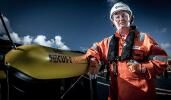6
Over the last 20 years, an increasing awareness of the field of geotechnical engineering has led to it becoming a key discipline for all major offshore construction projects. As one of the more popular roles in the offshore industry, Atlas’ geologists have been able to take part in exciting projects around the world, exploring and investigating the oceans’ subterranean structures.
Finding the right career path
Since the age of 16, engineering geologist Aidan Flint has been studying his chosen subject and getting his hands dirty in the process, “There used to be a popular joke that geologists were just people who just liked to walk around muddy fields with their friends; which is true in some respects,” laughs Aidan. “Working outdoors in all weathers definitely appealed to me, however, it wasn’t quite clear how one could progress onto this career path. When I was an undergraduate, most of the academic courses focussed on petroleum exploration rather than geotechnical applications.”
Solving great technical challenges
20 years later, Aidan has gained a broad industry experience working in a variety of geotechnical survey applications including infrastructure, oil & gas, wind farm and marine construction projects. Whether it be individual wind turbine foundations or large scale submarine cable burial assessments, Aidan still finds new challenges with every offshore project. “The role of an engineering geologist is to characterise the engineering behaviour of the subsurface via a ground model which ultimately provides input parameters for geotechnical design. The geotechnical ground model is effectively an engineering decision making tool. More complex ground conditions generally present a greater technical challenge, and also a good opportunity to demonstrate the value of high quality subsurface investigation to the wider engineering team. Such information typically facilitates key decisions, which in the case of an offshore wind turbine could be selection of a suitable foundation type, or in the case of a subsea cable route a suitable construction technique to ensure the product is properly buried and protected from seabed or maritime hazards. The terminology and language can be daunting to non-specialists, so often my most important role is explaining the significance of key findings to the client team, so they can appreciate project risk in its various forms.”
The “FAB” Link Project
Since the end of last year, Aidan has been working on the preconstruction survey for the “FAB” link project; a 1000 to 1400MW High Voltage Direct Current (HVDC) electricity interconnector that will connect the French and British grids via the island of Alderney (hence FAB). Atlas’ Offshore Management & QC office, based in Exeter, assigned Aidan to the role after receiving sole supplier status for the project. “This was a particularly interesting project,” says Aidan, “I was offshore for three months as a client representative and oversaw the entire geotechnical survey during which we investigated approx. 170 linear kilometres of shallow geology. This was particularly challenging for two reasons, the first being the overall scale of the project which made it difficult to select representative locations to obtain samples or perform in-situ testing. This was generally achieved by analysing results of a contemporary geophysical survey which allowed us to select strategic locations. Analysing the significant volume of geophysical data on a tight time schedule was a big challenge. The second and possibly most fascinating aspect was obtaining deep geotechnical data to assess the feasibility of employing Horizontal Directional Drilling (HDD) construction techniques at several proposed cable landfall sites. Successful HDD construction is highly dependent upon geological conditions and represents a specialist field within the geotechnical industry. A structured decision-making framework was developed to allow practical site based assessments, and to see whether sufficient data had been obtained in light of the encountered ground conditions. This approach required a significant amount of engineering judgement and close co-operation between the site and office based teams.”
The FAB project has been noted as a “Project of Common Interest” by the European Union. The project’s maximum transmission of 1400MW will increase the capacity of energy trade between the two countries.
Academic research to the forefront of geology
Over his career, Aidan has found that the frontiers of the geotechnical industry are forever-expanding, “the offshore wind industry has contributed significantly to the advancement of geotechnical design and innovation. The completion of each project, whether it be a cable-lay or a turbine installation, provides additional experience and new data to fuel further academic research at the forefront of our discipline. As the offshore wind industry moves into deeper and more hostile marine environments, the industry must keep innovating to keep costs down. Although geotechnical engineering is a niche market, it will undoubtedly play a crucial role in helping the offshore construction sector realise long term growth and sustainability; so for me, it’s an exciting time to be an engineering geologist.”
.png)
.png)


